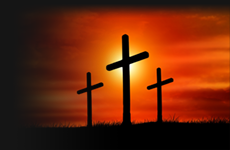Jesus' Crucifixion In Art
The symbol of Christ on the cross has infiltrated culture in innumerable ways, and depictions have become ubiquitous. There is no other subject matter that better reflects the historical progression of artistic expression. This is fitting, as there is no other event that has had comparable effect on all aspects of human history.

"The Crucifixion"
Artist: Juan de Flandes
1509 - 1519
Painting
In his depiction of the historic image of the Crucifixion on the central panel of Palencia Cathedral’s main altarpiece, Juan de Flandes chose the iconographic type that Réau calls de grand spectacle, which was appropriate for the panel’s large dimensions and horizontal format, and undoubtedly the one preferred by the painter’s client. Here, he reduced that type to its essential elements, a customary approach for this Flemish painter, and one that is even more accentuated in this work from late in his career, where the large size of the figures requires including less of them in the composition.

"The Small Crucifixion"
Artist: Matthias Grunewald
1511
Painting
Matthias Grünewald (ca. 1480–1528) painted the Crucifixion as a panel for the Isenheim Altarpiece in the hospital chapel of St. Anthony’s monastery. The monastery hospital specialized in the treatment of ergotism, an especially painful skin disease.
- page 13 of 38 -
